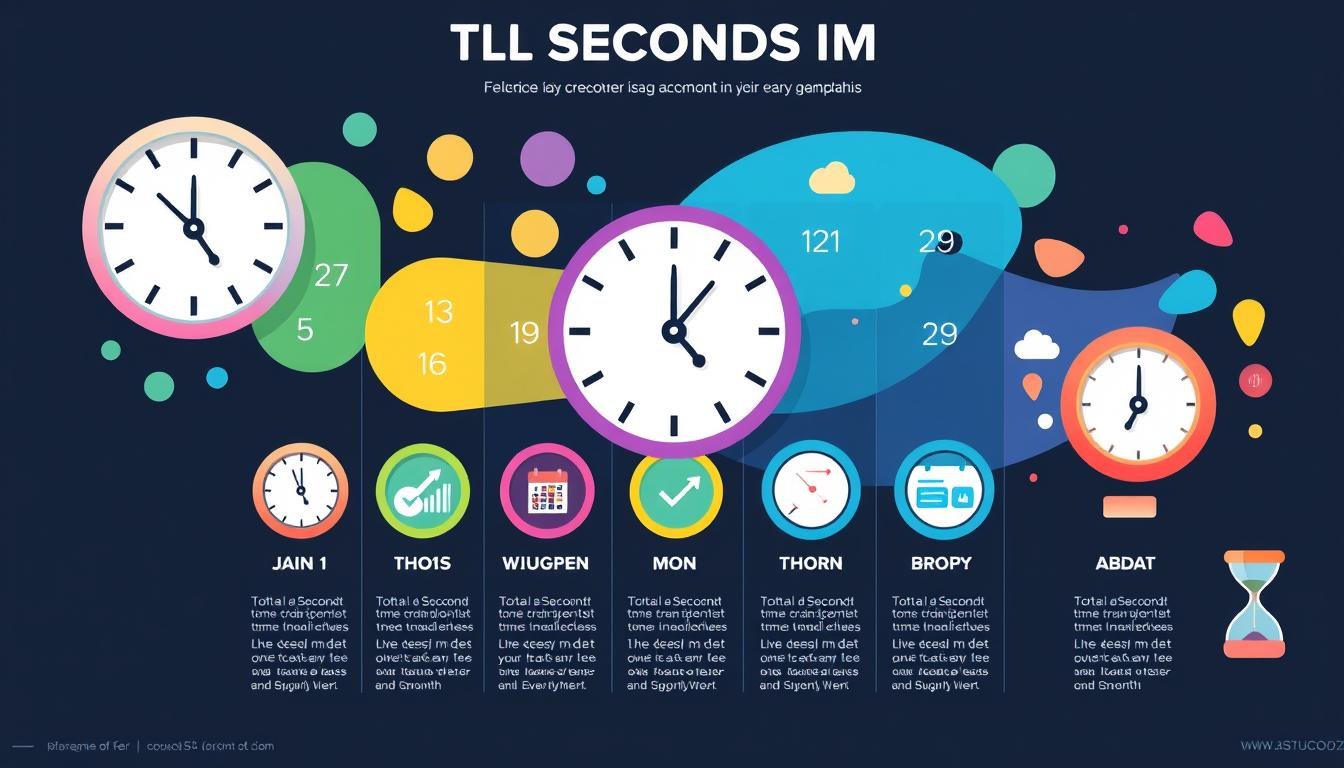A surreal clock melts over an abstract landscape, with numbers representing seconds floating around. It is surrounded by a celestial backdrop of stars and planets, intricate gears and cogs intertwining, and vibrant colours blending harmoniously to convey the concept of time and its calculation in a month.
Time calculation helps us break down time into precise measurements. It’s easier than you think to understand seconds in a month.
Converting months to seconds can be useful in many ways. This skill is helpful for students, professionals, and curious minds alike.
The number of seconds varies for each month. It depends on how many days are in that month.
February is the shortest month. December is the longest month.
This guide will teach you how to convert months into seconds. You’ll learn simple techniques to make these calculations easy.
We’ll examine different ways to measure time, and you’ll gain new insights into how we track time.
Understanding these calculations will change how you see time. It affects how we manage our daily lives.
Knowing seconds in a month is helpful in many fields. It helps in scientific research and project planning.
Precise time conversions improve accuracy in various tasks. This knowledge can make a big difference in your work.
Understanding Time Units: Seconds, Minutes, and Hours
Time measurement helps us organize our daily lives. Seconds, minutes, and hours are the basic units of time tracking.
Seconds are the smallest practical unit of time measurement. They quickly pass, forming the foundation for more extended periods.
Sixty seconds make one minute. Minutes help track cooking, exercise, or short tasks.
Sixty minutes create an hour. Hours help organize schedules, work shifts, and personal routines.
These time units are key for complex calculations. They’re essential for tracking work, planning events, and analyzing data.
How to Calculate Seconds in a Month
Calculating seconds in a month is easy. Most months have 30 or 31 days, except February.
To find seconds, multiply days by 24 hours, 60 minutes, and 60 seconds. A 31-day month has 2,678,400 seconds.
February usually has 28 days, but 29 in leap years. Check the month’s length for exact calculations.
Online tools and apps can help you convert time quickly. They remove the need for manual math.
This method helps track projects and research. It helps you manage time better.
Standard Month Lengths and Their Seconds
Month lengths vary, affecting time calculations. Most months have 28 to 31 days, changing the total seconds.
Seven months have 31 days, four have 30 days, and February has 28 days, or 29 in leap years.
A 31-day month has 2,678,400 seconds. A 30-day month has 2,592,000 seconds.
February has 2,419,200 seconds in regular years. In leap years, February has 2,505,600 seconds.
Leap years occur every four years. They add a day to February, keeping our calendar in sync with Earth’s orbit.
Quick Reference: Seconds in Each Month
A visually striking infographic design illustrating the total seconds in each month, featuring a clean layout with distinct sections for every month, adorned with vibrant colours and dynamic shapes representing time. Include abstract representations of clocks, hourglasses, and calendars to symbolize time while maintaining an organized and easy-to-read format without any text or characters.
Knowing seconds per month helps with exact time calculations. Our guide shows the seconds for each month.
Here’s a simple breakdown of seconds in each month:
- January: 2,678,400 seconds
- February (non-leap year): 2,419,200 seconds
- February (leap year): 2,505,600 seconds
- March: 2,678,400 seconds
- April: 2,592,000 seconds
- May: 2,678,400 seconds
- June: 2,592,000 seconds
- July: 2,678,400 seconds
- August: 2,678,400 seconds
- September: 2,592,000 seconds
- October: 2,678,400 seconds
- November: 2,592,000 seconds
- December: 2,678,400 seconds
This guide makes monthly time calculations easy. It helps researchers, project managers, and curious minds.
Remember, leap years add extra seconds to February. This can affect detailed time-tracking projects.
Converting Seconds to Other Time Units
Time unit conversion is vital for precise measurements. It’s useful for scientific projects and everyday curiosity about time.
Converting seconds is easy. Divide seconds by 60 for minutes. For hours, divide by 3,600.
Here are some quick conversion formulas:
- 1 minute = 60 seconds
- 1 hour = 3,600 seconds
- 1 day = 86,400 seconds
Many fields use seconds to minutes and hours conversion. Researchers and athletes often need exact time measurements.
Digital tools can help with complex time calculations. They make conversions much simpler.
Practice makes the perfect in-time unit conversion. Start small and work up to more complex problems.
Fun Facts About Time
Time is full of fascinating quirks. A day on Venus is longer than its entire year!
Light travels about 186,000 miles per second. It can circle Earth seven times in one second!
Our brains process time differently based on age. Children feel time moves slower, while adults think it speeds up.
Our time perception changes with our mental state. Emotions can alter how we experience time’s passage.
Counting to one million would take about 11.5 days. Counting to one billion would need nearly 32 years!
Quantum physics suggests time might not be linear. Atomic clocks can measure time with incredible precision.
These clocks would only lose one second in 15 billion years. Such facts challenge our understanding of time measurement.
Practical Applications of Time Calculations
Time-based calculations are vital in many work and personal situations. They help managers plan projects better and break down big tasks.
Professionals use these calculations to make essential choices. Freelancers use them to bill clients correctly.
Software developers use time estimates to plan their work. This helps them finish projects on time.
Time management makes businesses more productive. It helps leaders improve workflow and reduce waste.
Project managers use time calculations to set good goals and to check the performance of teams.
Tech companies now use advanced time calculation tools. These tools help teams track progress and solve problems.
Small business owners find time measurements very useful. They can improve their work and make better plans.
Conclusion: The Importance of Knowing Time Calculations
Time measurement skills are vital for personal and work success. They help you manage your day better and make wise choices.
Time management is about organizing your activities well. It helps you set goals and reach your full potential.
Understanding time units gives you more control over your schedule. You can plan your work better and get more done.
Time skills are helpful in many jobs. Project managers use them for deadlines and athletes for training.
Students and workers can use these skills to work faster, reduce wasted time, and be more organized.
Using time calculations can change how you see your day. It can help you be more productive and live with purpose.
FAQ
How many seconds are in a typical month?
The number of seconds in a month changes based on its length. A 30-day month has 2,592,000 seconds.
A 31-day month has 2,678,400 seconds. February usually has 2,419,200 seconds (28 days) or 2,451,600 seconds (29 days).
How do you calculate seconds in a month?
Multiply the days by 24, then by 60, and again by 60. For a 31-day month: 31 × 24 × 60 × 60 = 2,678,400 seconds.
Why do months have different numbers of seconds?
Months have different lengths – 30, 31, or 28/29 days for February. Longer months have more total seconds than shorter ones.
How many seconds are in a leap year’s February?
In a leap year, February has 29 days, equaling 2,505,600 seconds. This is 86,400 seconds more than a 28-day February.
Can I quickly convert months to seconds?
Use 2.6 million seconds as a quick guess for a typical month. For exact figures, multiply the month’s days by 86,400.
Are there practical uses for knowing seconds in a month?
Yes! This info helps in project planning, science work, and billing. It’s also valid for time-sensitive contracts that need exact time measures.
How do seconds in a month relate to other time units?
One month has about 2.6 million seconds. This equals roughly 43,200 minutes or 720 hours.
you may also read : Explore the Twelve Months of the Year in Detail


